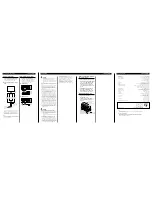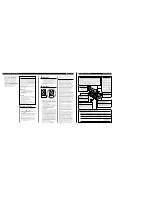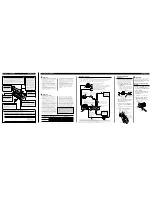
Connecting the Unit
<ENGLISH>
Using the Speaker Input
Connect the car stereo speaker output
wires to the amplifier using the supplied
speaker input wire with RCA pin cord.
• Slide the input switch to the right.
7
Connections when using the speaker
input
• As a result of connecting the car stereo speaker
output wire to the amplifier, the power of the
amplifier is turned on automatically when the car
stereo is turned on. It is not necessary to connect
the system remote control wire in this case.
Note:
• Connect the system remote control wire when the
power of the amplifier is not to be turned on when
the car stereo is turned on.
Connecting the Speaker Wires
The speaker output mode can be two-chan-
nel (stereo) or one-channel (mono).
Connect the speaker leads to suit the mode
according to the figures shown below.
• Do not connect both the RCA input and the
speaker input at the same time.
Two-channel (stereo)
One-channel (mono)
CAUTION
• Do not install in:
—Places where it could injure the driver or pas-
sengers if the vehicle stops suddenly.
—Places where it may interfere with the driver,
such as on the floor in front of the driver’s
seat.
• Make sure that wires are not caught in the sliding
mechanism of the seats, resulting in a short-cir-
cuit.
• Confirm that no parts are behind the panel when
drilling a hole for installation of the amplifier.
Protect all cables and important equipment such
as fuel lines, brake lines and electrical wiring
from damage.
• Install tapping screws in such a way that the
screw tip does not touch any wire. This is impor-
tant to prevent wires from being cut by vibration
of the car, which can result in fire.
• DO NOT allow amplifier to come into contact
with liquids due to, for example, the location
where the amplifier is installed. Electrical shock
could result. Also, amplifier and speaker damage,
smoke, and overheating could result from contact
with liquids. In addition, the amplifier surface and
the surface of any attached speakers could become
hot to the touch and minor burns could result.
• To ensure proper installation, use the supplied
parts in the manner specified. If any parts other
than the supplied ones are used, they may damage
internal parts of the amplifier, or they may
become loose causing the amplifier to shut down.
• Never replace the fuse with one of greater value
or rating than the original fuse. Use of an improp-
er fuse could result in overheating and smoke and
could cause damage to the product and injury
including burns.
CAUTION:
To prevent malfunction and/or injury
• To ensure proper heat dissipation of the amplifier,
be sure of the following during installation.
—Allow adequate space above the amplifier for
proper ventilation.
—Do not cover the amplifier with a floor mat or
carpet.
• DO NOT allow amplifier to come into contact
with liquids due to, for example, the location
where the amplifier is installed. Electrical shock
could result. Also, amplifier and speaker damage,
smoke, and overheating could result from contact
with liquids. In addition, the amplifier surface and
the surface of any attached speakers could become
hot to the touch and minor burns could result.
• Do not install the amplifier on unstable places
such as the spare tire board.
• The best location for installation differs with the
car model and installation location. Secure the
amplifier at a sufficiently rigid location.
• Make temporary connections first and check that
the amplifier and the system operate properly.
• After installing the amplifier, confirm that the
spare tire, jack and tools can be easily removed.
Power source ........................................................................................................ 14.4 V DC (10.8 V to 15.1 V allowable)
Grounding system .......................................................................................................................................... Negative type
Current consumption .................................................................................................... 25.8 A (at continuous power, 4
Ω
)
Average current drawn* ........................................................................................................ 8.7 A (4
Ω
for two channels)
17.6 A (4
Ω
for one channel)
17.6 A (2
Ω
for two channel)
Fuse ........................................................................................................................................................................ 30 A
×
2
Dimensions .................................................................................................................... 304 (W)
×
56 (H)
×
202 (D) mm
[12 (W)
×
2-1/4 (H)
×
8 (D) in.]
Weight .................................................................................................... 2.9 kg (6.4 lbs.) (Leads for wiring not included)
Maximum power output .......................................................................................... 300 W
×
2 (4
Ω
) / 1 200 W
×
1 (4
Ω
)
Continuous power output ........................................................ 150 W
×
2 (at 14.4 V, 4
Ω
, 20 Hz to 20 kHz 1.0% THD)
600 W
×
1 (at 14.4 V, 4
Ω
, 1 kHz 1.0% THD)
300 W
×
2 (at 14.4 V, 2
Ω
, 1 kHz 1.0% THD)
Load impedance ...................................................................................................................... 4
Ω
(2
Ω
to 8
Ω
allowable)
(Bridge connection: 4
Ω
to 8
Ω
allowable)
Frequency response ........................................................................................................ 10 Hz to 40 kHz (+0 dB, –3 dB)
Signal-to-noise ratio .................................................................................................................... 100 dB (IHF-A network)
Distortion ........................................................................................................................................ 0.005 % (10 W, 1 kHz)
Separation .................................................................................................................................................... 70 dB (1 kHz)
Low pass filter ............................................................................................................ Cut off frequency: 40 Hz to 120 Hz
Cut off slope: –12 dB/oct
High pass filter .......................................................................................................... Cut off frequency: 40 Hz to 120 Hz
Cut off slope: –12 dB/oct
Bass boost ................................................................................................................................................ Frequency: 50 Hz
Level: 0, 6, 9, 12 dB
Gain control .................................................................................................................................... RCA: 400 mV to 6.5 V
Speaker: 1.6 V to 26 V
Maximum input level / impedance .................................................................................................... RCA: 6.5 V / 22 k
Ω
Speaker: 26 V / 90 k
Ω
Power output ...................................................................................... 150 W RMS
×
2 channels
(4
Ω
and 1
%
THD+N)
600 W RMS
×
1 channel
(4
Ω
and 1
%
THD+N)
300 W RMS
×
2 channels
(2
Ω
and 1
%
THD+N)
Signal-to-noise ratio ............................................................ 80 dBA (Reference: 1 W into 4
Ω
)
Note:
• Specifications and the design are subject to possible modification without notice
due to improvements.
*Average current drawn
• The average current drawn is nearly the maximum current drawn by this unit
when an audio signal is input. Use this value when working out total current
drawn by multiple power amplifiers.
Specifications
<ENGLISH>
Installation
<ENGLISH>
Speaker
output
Car Stereo
Speaker input
wire with RCA
pin cord
To RCA
input jack of
this unit.
White:
Black:
Black:
Red:
Left
+
Left
≠
Right
≠
Right
+
(Right)
Speaker
(Left)
Speaker
(Mono)
Example of installation on the floor
mat or on the chassis
1. Place the amplifier where it is to be
installed. Insert the supplied tapping
screws (4
×
18 mm) into the screw
holes. Push on the screws with a
screwdriver so they make marks
where the installation holes are to be
located.
2. Drill 2.5 mm (1/8 inch) diameter
holes at the point marked, and
install the amplifier, either on the
carpet or directly to the chassis.
Replacing the terminal cover
1. Align the unit and terminal cover,
and insert the screw.
2. Tighten the screw with a 4 mm or
5/32 inch hexagonal wrench (not
supplied).
Drill a 2.5 mm (1/8 inch) diameter hole
Tapping-screws
(4
×
18 mm)
Floor mat
or chassis
Screw
Terminal Cover


























